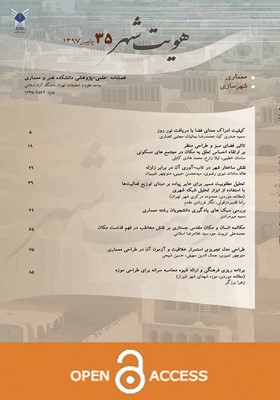برنامه ریزی فرهنگی و ارائه شیوه محاسبه سرانه برای طراحی موزه (نمونه موردی : موزه شهدای شهر شیراز)
محورهای موضوعی : معماری
1 - مدرس، گروه معمارى، دانشکده هنر و معمارى، واحد شیراز، دانشگاه آزاد اسلامى، شیراز، ایران.
کلید واژه: موزه, مبانی برنامهریزی طراحی موزه, برآورد سرانه, تخمین مساحت,
چکیده مقاله :
موزهها ابزار حفظ هویت فرهنگی و به زبان دیگر اساس دوام و بقای جامعه هستند. اما ساخت موزه بر اساس نیازسنجی و سرانه موردنیاز واقعی توجیهپذیر و ممکن است. رویکرد اصلی مقاله حاضر، تخمین سرانهها و مساحتهای موزه شهدا در شهر شیراز است و هدف، دستیابی به روش مطلوب تخمین تعداد بازدیدکنندگان و مساحت ریز فضاهای موزه شهدا و ارائه الگو جهت دیگر نمونههای موزه است. نمونه موردی این مقاله موزه شهدای استان فارس است. در فرآیند حصول این هدف چهار روش برآورد جمعیت و سرانهها، نمونهگیری از مساحتهای موجود داخلی و خارجی، نمونهبرداری از تعداد بازدیدکنندگان، برآورد سرانهها و مساحتها همزمان پیش برده شد. در انتها با توجه به هر چهار روش، تعداد بازدیدکنندگان و مساحت موردنیاز هر بخش موزه شهدا به دست آمد. روش تدوینشده میتواند الگویی جهت تدوین دیگر برنامههای کالبدی باشد.
Lack of stability in identity for urban residences remarkably resulted in rupture of any connection between inhabitants and environment or the inhabitants themselves. “At the top priority, museums are expected to preserve the identity of culture in a society. Museums play a key role in preservation of culture, and in another word, these monuments are the essentiality of survival, as well as durability for a human society”. In addition, the case study city (Shiraz) has two benefits: a cultural tissue in city, and having lots of museum visitors. Thus this city needs more spaces like museums and other cultural buildings. Amongst the most popular monuments is Martyr and War museum which implicate the approach of today life of Iranian society. However, the crucial objective of this study is to present the general principles for designing a museum as a branch of planning. Although we know the population of city, but estimating the necessary space of a museum is difficult. Consequently, the current study includes estimation of per capita, as well as spaces suitable for such projects. For this purpose, based on previous studies, as well as samples and statistics are used to estimate the population and visitors using sampling and standards. This study aims to seek a proper method to estimate the number of visitors, as well as occupied spaces for Martyr Museum located in Fars Province. Overall, there could be counted four different methods for the current study, including: estimation of population and per capita, sampling from present spaces, sampling of visitors, estimation of per capita and spaces. In each step, certain statistics were needed. After estimating of population, as the most preliminary method, based on universal, as well as Iranian per capita reference, necessity or non-necessity of the museum construction was assessed. In the second method, occupied spaces of certain internal and external museums were compared and the total required space was eventually calculated. Third step was processed on the basis of sampling from visitors of war museums worldwide and museums located in Tehran and Shiraz City (particularly Martyr museum). Finally, according to the statistics, simply number of visitor and required spaces for constructing these monuments could be assessed. Results showed the considerable lack of cultural areas like museums in Iran and the whole region. In this regard, per capita considered for cultural spaces in the country is less than universal standards. Moreover, the total visits of this Museum in daily visits and peak visits for special days were evaluated. Results illustrated that number of visits from Martyr museum showed a significant difference compared with other museum which attract every cultural designer. Meanwhile, space of the whole cultural area is estimated by comparing the other Iranian monuments. Thereupon, calculation of the required spaces would be simplified in this manner. However, as induced from the present study, physical planning of a process is basically structured on the basis of society requirements. Hence, the current presented method could be applicable for the further physical plans in future.
1. ارزیابی کمی مکانهای فرهنگی در ایران. (1383، 15 فروردین). روزنامه همشهری، شماره 3340، سال دوازدهم، ص 12.
2. برای هر یکمیلیون نفر یک موزهداریم. (1381، 1 خرداد). روزنامه ایران، فرهنگ و هنر، شماره ۲۱۳۱، سال هشتم، ص 6.
3. سازمان میراث فرهنگی و گردشگری استان فارس. (1389). آمار بازدیدکنندگان از موزههای استان فارس. شیراز: معاونت فرهنگی سازمان میراث فرهنگی و گردشگری استان فارس.
4. سازمان میراث فرهنگی و گردشگری کل کشور. (1389). آمار ارائهشده، تهران: معاونت معرفی و آموزش سازمان میراث فرهنگی کشور ـ اداره کل گنجینهها و نمایشگاهها.
5. سرانههای موزه در ایران. (1381، 1 خرداد). روزنامه ایران، شماره 55، ص 11.
6. شریعت زاده، سید علیاصغر. (1374). موزهها: جلوگان اندیشه و هنر. مجله میراث فرهنگی، 14، 61-69.
7. شریعتی، علی. (1376). حسین وارث آدم. تهران: چاپخش.
8. شیخالاسلام زاده، محمدرضا. (1378). نقش موزه در توسعه فرهنگی. مجله موزهها، 1(22)، 90-102.
9. شیرازی، باقر. (1370). موزه مکان فرصتهای استثنائی. مجله موزهها، 11، 33-49.
10. شیعه، اسماعیل. (1387). مقدمهای بر مبانی برنامهریزی شهری. تهران: انتشارات دانشگاه علم و صنعت.
11. منصور زاده، یوسف. (1378). نقش آموزشی موزهها در توسعه پایدار. مجله موزهها، 1(22)، 75.
12. موزه شهدای تهران. (1389). آمار بازدیدکنندگان. تهران: موزه شهدای تهران.
13. موزههای ایران. (1389). آمار بازدیدکنندگان سایر موزهها از طریق دفاتر روابط عمومی یا روابط عمومی سازمان مربوطه، تهران.
14. Mahmodi, M.(2009). Retried march, 2009, from http://www.checnevis.
15. Imperial war meuseum (2010). Retried march, 2009, from http://www.iwm.org.uk/


